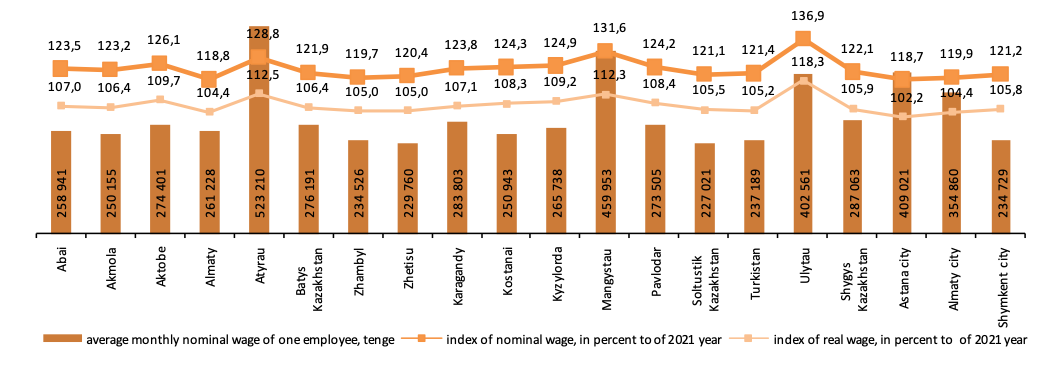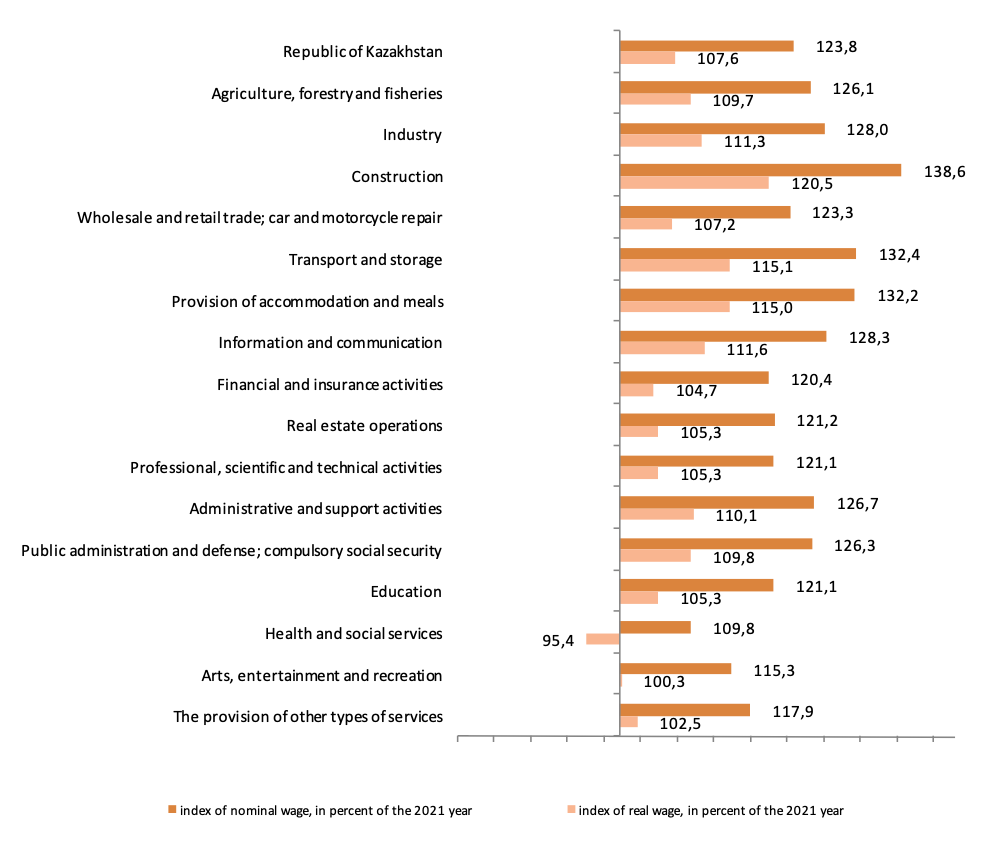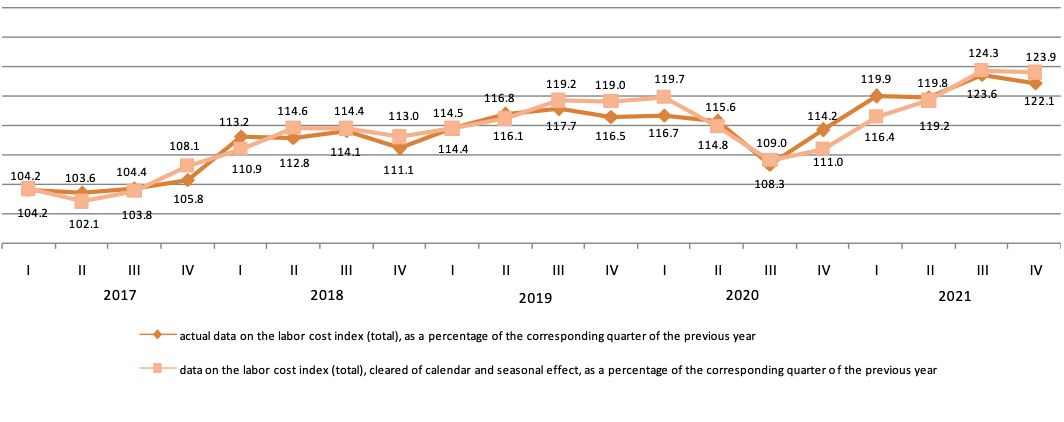Over the past five years, average wages have increased by 1.9 times, while women's earnings have grown at a faster pace thanmen's.
| 2018 | 2019 | 2020 | 2021 | 2022 | Nominal wage index 2022 by 2018 | Real wage index 2022 by 2018, in % | |
|---|---|---|---|---|---|---|---|
| Total | 162 673 | 186 815 | 213 003 | 250 311 | 309 867 | 1,9 times | 136,4 |
| men | 195 959 | 222 514 | 243 524 | 281 239 | 355 296 | 1,8 times | 129,8 |
| women | 129 039 | 150 779 | 182 679 | 220 160 | 265 762 | 2,0 раза | 147,5 |
| 2020 | 2021 | 2022 | |
|---|---|---|---|
| Republic of Kazakhstan | 142 718 | 165 816 | 204 149 |
In the regional context, the highest average monthly nominal salary was noted in Atyrau region, which amounted to 523 210 tenge, Mangystau region – 459 953 tenge, in Astana city – 459 953 tenge.
The highest growth compared to the previous year was recorded in Ulytau region by 36.9%, Mangystau region – by 31.6% and Atyrau region – by 28.8%.
The lowest wages are observed in Soltustik Kazakhstan region – 227 021 tenge, in Zhetisu region – 229 760 tenge, in Zhambyl region – 234 526 tenge and in Shymkent city – 234 729 tenge .

The average monthly wages is growing faster than in 2021 in the Construction– by 38.6%, in Transport and storage – by 32.4%, in Provision of accommodation and meals – by 32.2%.
In the industry structure, the highest nominal wages are recorded in the Mining and quarrying industry – 2.1 times higher than the national average, in Financial and insurance activities – 1.8 times, in Professional, scientific and technical activities – 1.5 times, in the field of Information and communications – 1.4 times, respectively.
The smallest increase in the level of the average monthly nominal wages was noted in the Human health and social work activities - 9.8%.
| Average monthly nominal wage of one employee | |||
|---|---|---|---|
| tenge | in percent of the corresponding period last year | ||
| index of nominal salary | index of nominal salary | ||
| Republic of Kazakhstan | 309 867 | 123,8 | 107,6 |
| Agriculture, forestry and fishing | 190 086 | 126,1 | 109,7 |
| Industry | 418 811 | 128,0 | 111,3 |
| Mining and quarrying | 653 345 | 129,6 | 112,7 |
| Manufacturing | 349 930 | 126,5 | 110,0 |
| Electricity, gas, steam and air conditioning supply | 268 615 | 125,8 | 109,4 |
| Water supply; sewerage, waste management and remediation activities | 189 274 | 122,4 | 106,5 |
| Construction | 416 940 | 138,6 | 120,5 |
| Wholesale and retail trade; repair of motor vehicles and motorcycles | 268 469 | 123,3 | 107,2 |
| Transportation and storage | 386 787 | 132,4 | 115,1 |
| Accommodation and food service activities | 272 811 | 132,2 | 115,0 |
| Information and communication | 436 980 | 128,3 | 111,6 |
| Financial and insurance activities | 560 459 | 120,4 | 104,7 |
| Real estate activities | 228 393 | 121,2 | 105,3 |
| Professional, scientific and technical activities | 458 832 | 121,1 | 105,3 |
| Administrative and support service activities | 308 465 | 126,7 | 110,1 |
| Public administration and defence; compulsory social security | 263 843 | 126,3 | 109,8 |
| Education | 248 575 | 121,1 | 105,3 |
| Human health and social work activities | 249 834 | 109,8 | 95,4 |
| Arts, entertainment and recreation | 185 040 | 115,3 | 100,3 |
| Other service activities | 292 656 | 117,9 | 102,5 |

In 2022, 1,060.6 thousand people were hired at enterprises and organizations, of which 94.5 thousand people - for newly created jobs and 4.9 thousand people - workers with disabilities.
1,017.7 thousand people left for various reasons, 19.2 thousand of them due to a reduction in the number of employees or liquidation of organizations, 851.1 thousand due to turnover reasons, and 147.4 thousand employees for other reasons.
In the context of regions, the largest number of employees is accepted in the city Almaty – 216611people, in Astana – 121274 people and in Atyrau region – 78488 people. Of these, 19081 people were accepted for newly created jobs in city Almaty, 12708 people in Astana and 11565 people in Turkestan region.
The highest rate of replaced jobs is observed in the Zhetisu region – 139.4%, Ulytau region – 133.6% and Turkistan region – 123.4%.
| Per employee | ||||||
| number of days worked | hours worked | number of unworked man-days | of them | |||
| paid annual leave (including additional leave) | due to illness | on leave without pay | ||||
| Total | 223,7 | 1 777,2 | 43,1 | 26,7 | 4,4 | 3,4 |
| Agriculture, forestry and fisheries | 253,1 | 1 952,8 | 37,2 | 19,1 | 4,5 | 6,7 |
| Industry | 218,9 | 1 745,0 | 43,5 | 24,1 | 7,3 | 4,5 |
| Mining and Quarrying | 214,8 | 1 729,1 | 44,5 | 26,8 | 7,5 | 2,8 |
| Manufacturing Industry | 220,5 | 1 750,9 | 43,8 | 22,6 | 7,2 | 5,7 |
| Electricity, gas, steam, hot water and conditioned air supply | 222,0 | 1 763,3 | 42,2 | 23,3 | 7,4 | 4,5 |
| Water supply; sewerage system, control over the collection and distribution of waste | 219,1 | 1 732,3 | 39,8 | 24,5 | 7,1 | 3,2 |
| Construction | 230,4 | 1 814,7 | 37,3 | 19,5 | 2,8 | 8,4 |
| Wholesale and retail trade; repair of cars and motorcycles | 227,1 | 1 778,9 | 39,4 | 16,6 | 3,8 | 5,1 |
| Transport and storage | 218,6 | 1 749,4 | 48,4 | 25,9 | 8,2 | 3,8 |
| Accommodation and catering services | 231,6 | 1 827,2 | 34,5 | 17,9 | 3,4 | 8,4 |
| Information and communication | 222,9 | 1 769,4 | 42,3 | 20,7 | 4,8 | 3,2 |
| Financial and insurance activities | 224,6 | 1 797,5 | 52,8 | 16,0 | 6,9 | 5,5 |
| Reale state operations | 219,4 | 2 078,2 | 54,7 | 16,1 | 4,1 | 4,5 |
| Professional, scientific and technical activities | 225,1 | 1 753,0 | 41,7 | 21,4 | 3,4 | 5,8 |
| Administrative and support activities | 226,9 | 1 800,2 | 31,9 | 19,1 | 3,7 | 3,1 |
| Government administration and defense; compulsory social security | 224,7 | 1 791,8 | 33,8 | 23,8 | 2,8 | 1,9 |
| Education | 220,2 | 1 739,7 | 47,0 | 36,8 | 2,8 | 1,8 |
| Health care and social services | 229,2 | 1 798,8 | 43,0 | 28,3 | 5,0 | 2,9 |
| Arts, entertainment and recreation | 223,9 | 1 775,0 | 33,9 | 22,5 | 2,8 | 1,6 |
| Provision of other types of services | 240,1 | 2 394,3 | 76,9 | 10,4 | 1,1 | 5,0 |
In 2022, 386.3 thousand people, or one in four (23.1%) of the total number of employees of the surveyed enterprises, worked in conditions that did not meet sanitary and hygienic requirements (norms).
Of these, almost every second (46.8%) worked under conditions of increased noise and vibration, every third (33.2%) worked under the influence of increased gas pollution and dustiness of the working area exceeding the MPC, and every sixth (16.7%) worked under unfavorable temperature conditions. 102.7 thousand people (6.1)% of the total number of employees of the surveyed enterprises were engaged in heavy physical labor.
Among women, one in eight (88.6 thousand people) worked in conditions that did not meet sanitary and hygienic requirements, of which 19.8% (17.5 thousand people) of women worked in a dusty and polluted environment.
207631.8 million tenge was spent on benefits and compensation for work in harmful and other unfavorable working conditions in 2022. The most common type of benefits - additional leave was granted – 531.9 thousand people, 404.3 thousand people used various material surcharges for harmful and other unfavorable working conditions, 321.9 thousand people received free milk or equivalent food, 88.6 thousand people received free therapeutic and preventive nutrition, 47.9 thousand people worked on a reduced working day.
For reference: The information in this section is formed based on the results of a survey of legal entities and (or) their structural and separate divisions with the main type of activity in the field of agriculture, forestry and fisheries, industry, construction, transport and warehousing, accommodation and catering services, information and communications, professional, scientific and technical activities, healthcare and social services, with the exception of small businesses engaged in entrepreneurial activities.The average annual total labor cost index, which characterizes the change in time of the average cost of labor costs per 1 hour worked, in 2022 compared to the previous year amounted to 122.5%, for the wage fund – 123.0%, for labor costs not taken into account in the wage fund – 119.3%.
| Labor Cost Index (general) | The index of the cost of labor by the wagefund | Labor cost index for labor costs not included in the wage fund | |
| 2018 | 112,8 | 111,6 | 120,6 |
| 2019 | 116,4 | 116,6 | 114,9 |
| 2020 | 113,6 | 114,8 | 106,5 |
| 2021 | 118,4 | 116,6 | 130,8 |
| 2022 | 122,5 | 123,0 | 119,3 |

Wages are an important form of income for a significant part of the economically active population, namely, employees. According to the Labor Code of the Republic of Kazakhstan, wages are remuneration for work depending on the qualifications of the employee, complexity, quantity, quality and conditions of the work performed, as well as compensation and incentive payments.
According to the ILO standards, there are four main groups of remuneration:
1) wages accrued at tariff rates and official salaries;
2) lump-sum payments and bonuses;
3) compensation payments related to working hours and working conditions;
4) payment for unworked time.
The average monthly nominal salary of one employee is determined by dividing the amount of the accrued salary fund by the actual number of employees and by the number of months in the reporting period.
Wage indices are tools used to evaluate trends or dynamics of wages. There are two wage indices: nominal and real.
The nominal wage index is a relative indicator that characterizes the change in wages in the reporting period compared to the base period.
The real wage index is a relative indicator that characterizes the change in nominal wages in the reporting period compared to the base period, taking into account price changes. The real wage index is determined by dividing the nominal wage index by the consumer price index for goods and services. Both indexes belong to the same time period.
Median salary is the amount of wages that is in the center of the distribution of the number of employees by the size of the accrued salary and divides it into two equal parts – with wages below and above the median.
Modal salary is the amount of wages that is most often found in the distribution of the number of employees by the amount of accrued wages.
The labor cost index is a relative indicator that characterizes the change in time of the average cost of labor costs per 1 hour worked.
The cost of labor costs is the sum of all the costs of employers (organizations) related to the maintenance and use of labor, regardless of the source of their financing.
The cost of labor costs not taken into account in the wage fund is the sum of the costs (expenses) of the employer (organization), which include: taxes related to the use of labor; expenses of the organization to provide employees with housing; expenses of the organization for social protection of employees; expenses for cultural events, as well as for recreation and entertainment organizations; expenses of the organization for the training of employees; expenses of the organization for labor not related to the above groups.
The objects of state statistical observations on wage statistics are all legal entities and their structural and separate subdivisions of all types of economic activity, with a population of over 100 people, as well as with a population of up to 100 people, except those reporting on the statistical form "On the activities of a small enterprise" (index 2-MP), regardless of their affiliation and forms of ownership.
State statistical observations of the average monthly salary, the composition of the wage fund, and the employer's labor costs are conducted using a continuous method.
The state statistical monitoring of wages by profession and position, the distribution of employees by salary is selective, that is, large enterprises by a continuous method, and medium and small by a selective method.